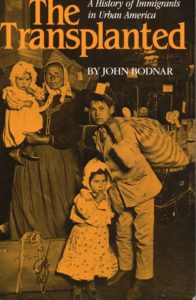Book Review: The Transplanted by John Bodnar
This volume, written in the 1980s, is a survey of patterns of immigration into urban areas of the United States between 1830-1930 (approximately.) It covers those who came to stay, those who just came to get a nest egg to improve life in their home country, and those who intended to go back but just never got around to it. Mr. Bodnar was and still is a professor of history at Indiana University.
The general theme of this book seems to be “it’s complicated.” The immigrant experience was not uniform, with their reactions and outcomes varying considerably depending on their initial motivations for emigration, the areas they came from, their initial social class and starting capital, and what part of America they ended up in. Trying to fit the immigrants into a single narrative that fits a particular philosophy doesn’t really work, according to Professor Bodnar.
It’s pretty dry stuff, starting with a chapter on the countries immigrants came from and focusing on when various regions had their largest numbers go. This isn’t a book for the casual reader.
The most interesting chapter for me was on religion and how their faiths both influenced how immigrants adapted to American life, and were forced to adapt themselves. Often there were clashes between those who felt they were (ethnicity) first, (religion) second, and those (especially religious leaders) who felt the reverse. One example was Slovak immigrants who were suspicious of their priests and ministers who preached in favor of Hungarian rule of the homeland. (It was later confirmed that the Austro-Hungarian Empire did indeed pay off religious leaders to spout pro-Hungarian propaganda in the U.S.)
Another conflict that often came up was between the urge to embrace Americanization and blend into their new society, and the fear of losing the unique cultural elements of their homeland or religious beliefs. This often led to a preference for parochial or ethnicity-based schools rather than putting children into the public school system.
There are extensive end notes, a bibliography and index, as well as a handful of black-and-white pictures.
Again, this isn’t a book for the casual reader, but is best suited for college students and up who are doing serious research on the subject of immigration. For most people, I’d recommend one of the many fine memoirs of immigrant families available at your local library.

